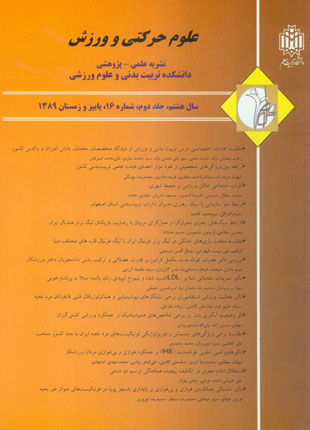The effect of aerobic and anaerobic functional fatigue protocols on dynamic postural stability in nonelite young soccer players
Author(s):
Hovanloof. , Sadeghih. , Montazerm. , Norouzi , H.R
Abstract:
In most tasks, most of the loss of force occurs because of the changes within the muscle or central nervous system or both of them. It appears to be a relationship between altered neuromuscular control and muscle fatigue that defined as any reduction in the force generating capacity of the total neuromuscular system regardless of the force required in any given situation. The purpose of this study was to examine the effect of aerobic and anaerobic functional fatigue protocols (AAFFP) on dynamic postural stability in nonelite young soccer players. Twelve healthy young male young soccer players who were playing in league one (Tehran) (age: 17.42 ± 0.51 y, weight: 67.65 ± 6.58 kg, height: 173.33 ± 3.09 cm) participated in this study. Before beginning the fatigue protocol, dynamic posture stability index (DPSI) evaluated following single leg jump-landing movement (athletic task that resulting injury) with sampling frequency of 200-HZ in 3 second recording. Stability indexes analysed in medial-lateral (MLSI), anterior-posterior (APSI) and vertical (VSI) direction. Immediately following fatigue, post testing was performed. The data was analyzed with descriptive statistic, multiple regression and analyses of variance (ANOVA) with repeated measures (p < 0.05). ANOVA revealed significant differences when comparing aerobic and anaerobic functional fatigue protocols pre test and post test values for MLSI, APSI, VSI and DPSI. But, no significant differences were revealed when comparing the protocols for peak vertical ground reaction force and post test of aerobic fatigue in APSI. In attention to this fatigue protocols probably eccentric contraction of hamstring muscles during the late swing phase to control forward motion of the thigh and leg segments, is case of altering in hamstring quadriceps muscle strength rate and decrease in knee stability. Also it seems that, subjects because of deceleration the body‚s downward velocity for decrease the impact force, altered mechanical mechanism of landing skill whit increasing in lower extremity joint flexion. The result of this investigation suggests that aerobic and anaerobic functional fatigue protocols, especially aerobic fatigue have effect in dynamic postural stability. This matter can be used as one of the main factors in determining of injury mechanism (in jump-landing movement). Therefore, recommended that coaches, athletes and athletic trainers for prevention the injury result of fatigue, they pay attention to the potential risks of control postural reduction in effect of both fatigue.
Language:
Persian
Published:
Journal of Motion and Sports Sciences, Volume:8 Issue: 16, 2012
Page:
165
magiran.com/p976790
دانلود و مطالعه متن این مقاله با یکی از روشهای زیر امکان پذیر است:
اشتراک شخصی
با عضویت و پرداخت آنلاین حق اشتراک یکساله به مبلغ 1,390,000ريال میتوانید 70 عنوان مطلب دانلود کنید!
اشتراک سازمانی
به کتابخانه دانشگاه یا محل کار خود پیشنهاد کنید تا اشتراک سازمانی این پایگاه را برای دسترسی نامحدود همه کاربران به متن مطالب تهیه نمایند!
توجه!
- حق عضویت دریافتی صرف حمایت از نشریات عضو و نگهداری، تکمیل و توسعه مگیران میشود.
- پرداخت حق اشتراک و دانلود مقالات اجازه بازنشر آن در سایر رسانههای چاپی و دیجیتال را به کاربر نمیدهد.
In order to view content subscription is required
Personal subscription
Subscribe magiran.com for 70 € euros via PayPal and download 70 articles during a year.
Organization subscription
Please contact us to subscribe your university or library for unlimited access!



